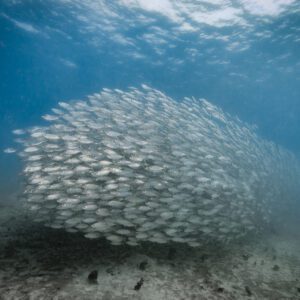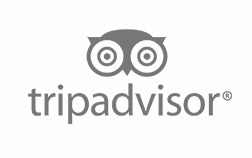A top Roatán dive site
Exploring the Roatán Blue Channel dive site is like getting three different dives in one.

There are many ways to explore this section of the Roatán reef, but our favorite way is navigating it from outside of the channel moving inward toward shore. The Roatán Blue Channel is one of the most popular Roatán dive sites thanks to its variety in wildlife and intriguing swim throughs. We usually navigate this site on a a relatively shallow dive profile under 40 feet / 12 meters. But it’s best explored by divers who have good buoyancy control due to the swim throughs and sections with a rapid decrease in depth.
Where is the Roatán Blue Channel?
The Roatán Blue Channel dive site is located off West End on the Northside of the island. If you’re looking for a landmark to associate it with, look no further than the famous beach bar Tita’s Pink Seahorse: the ‘Inside Blue Channel’ mooring line is directly west from here.
The channel is not man made. It’s a natural separation in the reef that creates a large channel that is filled with an abundance of coral and fish life. Boats can use this channel, making it easy for dive groups to get dropped off outside of the channel to then meet the boat inside.
You can theoretically get to the site from shore. But you utilize a lot of air in the the time it takes to get to the channel, leaving you little time to explore. And surface swimming to the site is not recommended because of the heavy boat traffic. Like most Roatán dive sites, the Blue Channel is really best explored by boat diving.
Why the Roatan Blue Channel is a must-see site
There’s so much that makes Roatán Blue Channel special. When navigating from the outside in, you first experience an intricate chain of

swim throughs in the reef that lead you up the channel toward shore. You then traverse a green field of sea grass teeming with macro life. Last, but definitely not least, you find yourself in what we lovingly call “the sand bowl”. While this nickname conjures up images of a barren seascape, an array of wildlife fill this part of the site. There’s also a small sailboat wreck that tons of cool creatures call home.
Many divers consider the Roatán Blue Channel to be one of the Top 10 Roatán Dive Sites. Nonetheless, visibility can vary more than other sites. Many divemasters will check the conditions prior to selecting the site. Be patient if they recommend saving it for another, clearer day!
Swim throughs
If you’re a swim-through junkie this site is for you. Enter the start of the swim throughs and Schoolmaster Snappers and Black Margate greet you at the mouth of the crevice. They appear to guide you through the tunnels. There are also a couple of openings where you can exit and cut the swim-through portion of the dive short. These openings also just serve as beautiful look out points before you enter the next dark tunnel. The swim throughs are quite shallow, so your safety stop timer might kick off. The quick change in depth also means you need to be mindful of your buoyancy. Portions of the swim throughs are also difficult to spot, appearing as dead ends. So, exploring the Roatán Blue Channel is best with an experienced guide.
Turtle grass field
Once you make your way through the channel, you find yourself in a lush field of turtle grass. On a sunny day, rays of sunlight appear to dance above the field making a particularly beautiful setting to float through. Look closely at every blade of grass and you find lots of macro life such as Nudibranchs and Blennies. But it’s not just tiny creatures that like to hang out here. If you’re lucky you will see the Eagle Rays that frequent this area soaring over these fields of green.
The sand bowl
The turtle grass field eventually gives way to what looks like a barren sand bowl. But look closer and a whole other world appears. Small headshield slugs appear in the sand. Inflated Sea Biscuit Urchins bury under the sand. Tons of Conch scuttle about. Every few meters beautiful, big sea stars mark your way. And as you continue to make your way toward the shore you come across a field of upside-down jellyfish. That’s right: jellyfish that swim and lie on the sand upside down. These jellyfish have symbiotic relationships with shrimps and nudibranchs, so be sure to take a very close look.
Big Eye Scads
One of the most exciting finds on this dive is the huge school of Big-Eyed Scads. We lovingly refer to these fish as ‘Goggle Eyes’ here on the island. The school moves in unison and sometimes it parts as you approach it with the scads then encircling you. One of the most shocking and thrilling experiences is witnessing a barracuda or large grouper stealthy hanging out in the middle of the circle. They then dart right in front of you as they try to score themselves a scad snack.
Sunken sail boat
As if the rest of the dive weren’t enough, the small sunken sailboat found at the Roatán Blue Channel is a treasure trove of juvenile life. Here you find small lobsters seeking shelter amongst the ruins, along with juvenile angelfish. Cork screw anemones also seem to love this spot and you see them in masses. Hiding amongst them are the Pedersen Cleaning Shrimp and Snapping Shrimp that they have a symbiotic relationship with.
Take a Virtual Dive thru the Roatan Blue Channel
Now, you can explore this stunning underwater playground from anywhere with this virtual tour of the Roatan Blue Channel. Swim through the winding coral passages, glide past schools of tropical fish, and experience the beauty that makes diving and snorkeling Roatan Blue Channel a favorite activity for so many.
Whether you’re planning your next dive trip or just dreaming of Roatan’s turquoise waters, this virtual dive brings you closer to the magic of the reef.
Want to virtually experience Roatan’s other popular dive sites? Dive into more virtual tours on roatandivesites.com.
Can you snorkel Blue Channel?
The Roatán Blue Channel is one of the best places to snorkel in Roatán thanks to how close to how shallow the reef is. From the surface you easily see an abundance of marine life. Check out the wide variety of colorful coral, including majestic elkhorn corals in the shallows. The channel is also teeming with fish such as Spotted Goatfish and Smallmouth Grunts. Eagle Rays frequent the site and swim through the channel. They also soar along the crest of the reef. Visibility changes frequently at this site, so it’s best to experience on a clear day. Your snorkel guide will check the conditions. And if you do get the chance to snorkel Blue Channel, take it!
The Roatán Blue Channel is an amazing spot for divers and snorkelers. And Sun Divers offers trips for both activities. Contact us to book your next dive or snorkel trip to Blue Channel.









